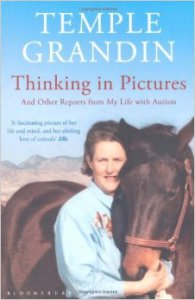I picked this book up for no particular reason, I wasn’t even sure what to expect. I’m intrigued by Temple Grandin the author of Thinking in Pictures – My Life with Autism. I was first introduced to her life in a movie, Temple Grandin. She is an expert on animal behavior and is responsible for designing many of the humane livestock-handling facilities in the US. She is also a spokeswoman for autism.
The book begins with Grandin describing her life with autism. She describes her difficulties learning as a child with autism. She developed a strategy of utilizing her extraordinary visual spatial skills to create a “video library.” Her verbal skills were very poor, but Temple’s brain processed everything as a picture. The video library is a resource for her in deciding how to behave in a social situation and allows her to design equipment and systems to move animals. Instead of drawing or verbally describing an idea, Grandin visualizes the design in every possible situation, with different breeds of cattle and in different weather conditions. She can predict flaws prior to construction. Her brain works like a virtual reality computer system only her perception is much more enhanced.
A significant portion of the book is dedicated to autism. I found this very interesting as my own knowledge of the condition is very limited. She impresses the fact that there is a “spectrum.” From low functioning to asperger’s, and each autistic individual has unique capabilities.
Grandin offers many suggestions and resources for parents of an autistic child. Many of the suggestions would benefit a parent of any child.For example, she discouraged the use of video games because the child becomes so addicted that he has no other interests. She doesn’t advocate a complete ban as it does give the child something to talk to other children about. General recommendations include social skills and manners. Temple was required to sit through formal Sunday dinners and behave. (sometimes she did). Rudeness was not tolerated and “please” and “thank you” were required. Again, these are social skills all children should learn. Playing games provided a situation to learn turn-taking, sharing and patience.
Oversensitivity is common for most autistics. Any of the senses can be a trigger – scratchy clothes, loud noises and bright lights can cause distress for an autistic person. I always think of the squeeze chute when I think of Temple Grandin. A squeeze chute is used to confine and calm cattle for branding, vaccines and tagging. Temple found personal comfort in a squeeze chute she build for herself. Occupational therapists create treatments to calm the nervous system, it can be swinging, a weighted vest or body massage. All intended to desensitize the nervous system.
I feel obliged to talk a little about her pages on the visual sense. I haven’t seen any unusual eye conditions that are more common in autistics, but the oversensitivity can be a problem. Avoiding bright lights and flickering lights with filters or using incandescent instead of fluorescent bulbs are solutions. For any child with visual processing problems a developmental optometrist can create a program of exercises to help the eyes and brain to work together.
Like anything having to do with the nervous system, early intervention is critical. The nerves and brain are still plastic and developing in young children. It is important to start therapy and education when an autistic child is young, so that developing nerve endings can make the right connections.
There is a whole chapter on medications. Like the variations in autism, so are the drugs, dosage and results. Temple encourages individuals and/or parents to closely monitor the use of pharmaceutical and amounts. Apparently, responses are vastly different for people with autism.
The book ends with Grandin’s search for the elusive answer to “what happens when we die?” As she spends so much time in cattle yards and slaughterhouses, she is not inexperienced on death so naturally she thinks about what’s next? She has a dream that takes place in a slaughterhouse, but she describes the upper floors. And as is typical of dreams the location doesn’t really make sense. What she finds in the upper levels consists of, “beautiful museums and libraries that contained much of the world’s culture. As I walked through the vast corridors of knowledge, I realized that life is like the library and the books can be read only one at a time, and each one will reveal something new.”
After reading Thinking in Pictures I have revealed many new things to myself, not just on autism, but people.
